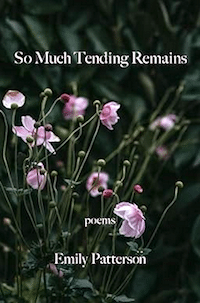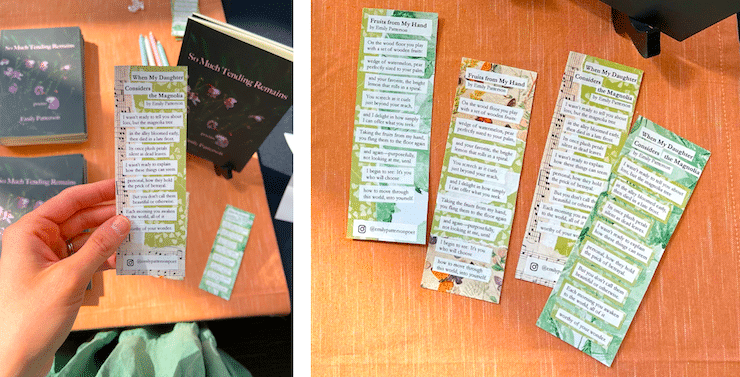About Emily Jean Patterson
Emily Jean Patterson is a curriculum designer, poet, and mother in Columbus, Ohio. She holds a B.A. in English from Ohio Wesleyan University, where she received the Marie Drennan Prize for Poetry. She also holds an M.A. in Education from Ohio State University. Emily’s work has been published or is forthcoming in Literary Mama, Mothers Always Write, Thimble Literary Magazine, Quillkeepers Press, Anti-Heroin Chic, The Sunlight Press, The Magnolia Review, North American Review, Rust & Moth, and elsewhere.
She is the author of Haiku at 5:38 a.m., So Much Tending Remains and To Bend and Braid. Her work has been nominated for the Pushcart Prize and Best Spiritual Literature. Emily can be found here on Instagram.
Listen In on Our Chat with Emily
Tweetspeak Poetry (TSP): Your recent collection—all haiku—explores life with a new baby. Interestingly, we did not originally read it that way. (We were thinking “insomniac and life with a beloved” 🙂 ). Why do you suppose the poems can be read so wildly differently than you intended?
Emily Jean Patterson (EJP): The brevity of the form, and its reliance on imagery, does leave room for varied interpretations! However, given the sleep deprivation of new parenthood, that description works as well. 🙂
TSP: We love your use of time stamps in haiku at 5:38 a.m. Each poem’s title bears a stamp. Can you say a little more about that choice?
EJP: Yes, the collection includes 24 poems, one for each hour of the day. Rather than flowing chronologically, they are intentionally scrambled to convey the fragmented sense of time in the postpartum period. I wrote the first poem during a long night, scribbling down the title “haiku at 3:34 a.m.” Throughout early motherhood, I continued to capture other moments as haiku, also marked by time of day—or night. I think this lends them a sense of immediacy and presence that new parenthood demands.
TSP: What is one of your favorite poems from the haiku collection? What makes it a fave? (Feel free to share the poem text 🙂 ).
EJP: Some of the poems in this collection allude to the anxiety I felt as a new parent, between postpartum depression and a global pandemic. In haiku at 5:38 a.m., I thought it was important to capture some of the fears and difficulties, in addition to the joys. This one stands out to me:
haiku at 11:06 p.m.
Weather in your lungs.
I count your slender breaths
like thin starlight.
The title poem is close to my heart as well, telling of my daughter’s birth:
haiku at 5:38 a.m.
Eyes tight, skin feathered,
voice a thousand doves uncaged.
You emerge.
TSP: At your first book festival, you brought along “collage bookmarks for good measure.” Did you create the collage art yourself? Have you found that making bookmarks available is helpful for book promotion? We’d love to see a picture of the bookmarks, too, if you have one to share!
EJP: Yes, I did! For my first chapbook, So Much Tending Remains (Kelsay Books, 2022), I selected shorter poems to feature on collage-art bookmarks.
I used them to thank those who purchased and to generate interest in the book.
Here’s one featuring a poem from that collection, “When My Daughter Considers the Magnolia” (originally published by Anti-Heroin Chic):
TSP: You are a curriculum designer. What kind of curriculum design do you specialize in? Does it play well with your poetic life—or is it a very separate part of your experience?
EJP: I design, write, and edit reading and supplemental literacy materials for elementary students. I love that I can be creative both in my daily work and as a poet! While they are separate endeavors, I think the writing process in each area can inspire and sharpen the other.
TSP: Your collection To Bend and Braid explores connections between parenthood and the natural world. How does it go about doing that? Do you have a particular love for the natural world? (And, if so, tell us how you came by it.)
EJP: I’ve always loved the natural world and spent much of my childhood outside. Now I love to hike, run, and explore the outdoors whenever I can—whether traversing a mountain in California or taking our dogs (two talkative huskies) for walks in our neighborhood. In To Bend and Braid, many of the poems take place outside, and were inspired by moments of my daughter discovering the world for herself.
TSP: You’ve noted that To Bend and Braid is a hard-won collection. What makes it so? Is there any encouragement you can offer to other writers as a result?
EJP: The title of To Bend and Braid (Kelsay Books, 2023) refers to the paradoxical nature of parenting a toddler—a child who is no longer a baby, growing ever more independent, yet still in need of close care. At first, I wasn’t sure what shape these poems would take; they were a shift from my first collection, but I couldn’t see how they fit together. I tried to trust the work, writing about the themes that mattered to me in this new stage of parenting. I gave each poem my full attention, then focused on their order and cohesion. Gradually a second chapbook emerged, a companion to So Much Tending Remains but also a standalone collection. So often, poetry—like parenting—is patient work. 🙂
Photo by Sandra Grünewald, Creative Commons, via Unsplash.
Read our review of haiku at 5:38 a.m.
- Poetry Prompt: Gathering Flowers - June 16, 2025
- Poetry Prompt: The Phoenix - May 26, 2025
- 10 Ways to Help Your Favorite Introverted Author: 1,000 Words - May 23, 2025



Bethany R. says
Love the time stamps too! (I’ve been time stamping flowers I gather in my journal and enjoy the specificity.) Delighted that you’ve been doing these interviews! 🙂 So inspiring with the visual layouts! <3
L.L. Barkat says
What fun, time stamping the flowers. I hope we’ll see pictures of that flower journal sometime! 🙂
Glad you’re enjoying the interviews, Bethany. I find it inspiring to hear how other poets/artists have journeyed and are still journeying.
Isn’t that a fun book mark idea? I might do that sometime.